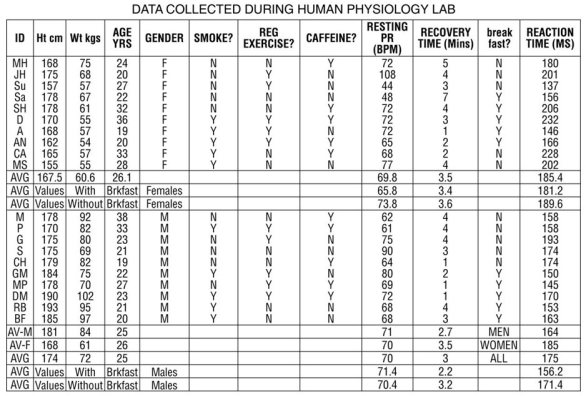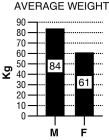Following is a table of data collected from one section of an 8 a.m.physiology lab.There were 20 students present,10 men and 10 women.Information collected from the students included their height,weight,age,and resting pulse rate.In addition,the students were surveyed to see if they smoked cigarettes,considered themselves "regular exercisers," if they had consumed caffeine the morning of the lab,and if they had eaten breakfast that day.A "y" or "n" (yes or no)was recorded to indicate their answers.Each student did "jumping jacks" for 5 minutes and recorded the time required to regain their resting heart rate,which is listed on the table as "recovery time." Finally,each student participated in an exercise designed to measure their reaction time (in milliseconds)in catching an object dropped by a lab partner according to specified criteria.Use this table to answer the following questions.Ignore statistical problems caused by small sample size,and so on.  Table 1.3
Table 1.3  For these questions,the data were separated and analyzed by gender.
For these questions,the data were separated and analyzed by gender.
-Refer to Table 1.3 and the bar graph.
A.Write a hypothesis regarding the effects of breakfast consumption on reaction time.
B.What is the dependent variable? What is the independent variable?
Definitions:
Aerobic Fitness
The capacity of the heart, lungs, and blood vessels to supply oxygen-rich blood to working muscles during extended physical activity, enhancing endurance.
All-Cause Mortality
The total number of deaths due to any cause in a specific population, used as a measure of the general health of that population.
Heart Disease
A range of conditions affecting the heart, such as coronary artery disease, heart rhythm issues, and heart defects.
Isokinetic
Referring to a type of muscle contraction in which the muscle shortens at a constant rate, often used in physical therapy and exercise testing.
Q13: How many grams of NaCl,m.w.58.5 daltons,are the
Q36: Dual direction testing involves samples of transactions
Q41: chondrocyte<br>A)cartilage<br>B)destroys bone matrix<br>C)loose connective tissue<br>D)fat<br>E)maintains bone matrix
Q58: Inherent risk and control risk differ from
Q61: Which of the following is not required
Q96: Regulatory-protein transcription factors bind to _ and
Q115: NADH is produced from each reaction described
Q116: to -50 mV from resting potential<br>A)electrical polarization<br>B)hyperpolarization<br>C)depolarization<br>D)repolarization<br>E)more
Q125: Isotopes of the same element differ by
Q139: What is the difference between cell movements